#23 November 1887
Explore tagged Tumblr posts
Text
Happy 136th Birthday, Boris!
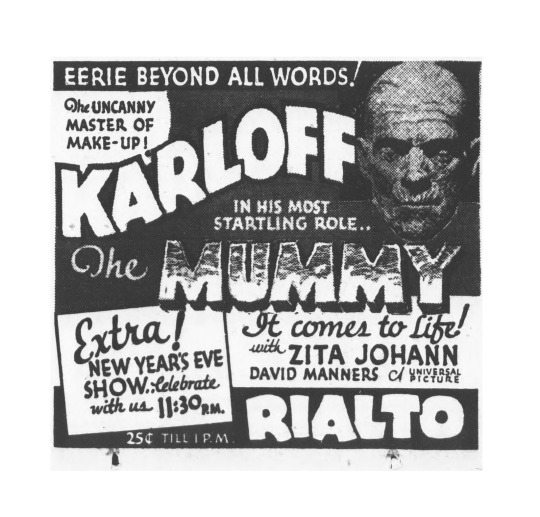
Source: The Washington Times, Friday, December 30, 1932.
#Boris Karloff#The Mummy#Universal Monsters#Zita Johann#David Manners#Edward Van Sloan#1932#vintage#newspapers#happy birthday#23 November 1887
91 notes
·
View notes
Text
Remembering Boris Karloff (November 23, 1887 - February 2, 1969).
#BorisKarloff
#TheMonster
#Frankenstein
#horror

#horror#horror movies#horror movie#scifi#science fiction#thriller#boris karloff#frankenstein#the monster
26 notes
·
View notes
Text




Boris Karloff was born William Henry Pratt on the 23 of November in 1887 #botd
83 notes
·
View notes
Text

Boris Karloff, November 23, 1887 – February 2, 1969.
66 notes
·
View notes
Text

Happy Birthday to the late great William Henry Pratt, known professionally as Boris Karloff, Who was born 137 years ago (November 23, 1887 - February 2, 1969). Oil paintings by my artist friend Michael Raymond.
10 notes
·
View notes
Text
Old Hollywood stars born between 1878 and 1891














Lionel Barrymore (1878, April 28)
Victor Sjöström (1879, September 20)
W.C. Fields (1880, January 29)
Cecil B. DeMille (1881, August 12)
John Barrymore (1882, February 15)
Bela Lugosi (1882, October 20)
Lon Chaney (1883, April 1)
Douglas Fairbanks (1883, May 23)
Walter Huston (1884, April 5)
Edward Everett Horton (1886, March 18)
Al Jolson (1886, May 26)
Boris Karloff (1887, November 23)
Charlie Chaplin (1889, April 16)
Ronald Colman (1891, February 9)
#lionel barrymore#victor sjöström#w.c. fields#Cecil B. DeMille#john barrymore#bela lugosi#lon chaney#douglas fairbanks#walter huston#Edward Everett Horton#al jolson#boris karloff#charlie chaplin#ronald colman#old hollywood#classic hollywood
14 notes
·
View notes
Text
Boris Karloff, born on this day, November 23, in 1887.

6 notes
·
View notes
Text

The Thibodaux Massacre took place in Thibodaux, Louisiana on November 23, 1887. Black sugar cane workers, determined to unionize for a living wage, chose to combine their minimal power during the crucial harvest season. Their actions sparked a massacre.
The cane workers protested the harsh working conditions, long hours, and starvation wages. They were fed subsistence meals and paid as little as 42 cents a day with scrip which could only be used in plantation stores.
The Knights of Labor encouraged the sugar cutters to demand better treatment and $1.25 a day in cash. They tried unsuccessfully to organize the workers in 1874, 1880, and 1883. In 1887, they waited until the rolling season was almost underway to propose making a stand. The planters were unable to attract enough strikebreakers from out of the area because of the low pay they offered. Junius Bailey, a schoolteacher and the president of the Terrebonne chapter of the Knights of Labor went to the growers with the sugar cutter’s demands.
The growers refused to negotiate and fired the union members on November 22, the strike was called and for the next three weeks, an estimated 10,000 workers went on strike.
White vigilantes locked down Thibodaux and went door to door attempting to identify strikers and demanding passes from any Blacks going in and out of town. As morning broke on November 23 two white guards were injured, and the massacre began.
The planters persuaded Governor Samuel D. McEnery, a Democrat and former sugar planter, to unleash several units of the all-white state militia. The militia brought a .45 caliber Gatling gun while the paramilitary groups set up outside of the Thibodaux courthouse. Both the militia and white vigilantes went door to door shooting suspected strikers and those unlucky enough to cross their path.
The indiscriminate killing left approximately 60 people dead. The bodies of many of the strikers were dumped in unmarked graves. Those who survived hid in the woods and swamps as the killings spread to other plantations. It was one of the deadliest episodes in US labor history. #africanhistory365 #africanexcellence
2 notes
·
View notes
Text
Charles Haddon Spurgeon

Charles Haddon Spurgeon (1834-1892) was called to pastor the New Park Street Chapel, London, when he was only nineteen. This church became the 6,000 seat Metropolitan Tabernacle, which he pastored until his death at age 58. Through his relatively short but phenomenally productive ministry, Spurgeon pastored, directed a Pastor’s College, oversaw a Bible and tract society, organized Stockwell Orphanage, published the monthly magazine Sword and Trowel, edited a weekly sermon (among the several he preached each week), and wrote a number of books, including his well-known Treasury of David.
Timeline of the Life of Charles Haddon Spurgeon (1834-1892)
1834 (June 19) – Born at Kelvedon, Essex.
1850 (January 6) – Converted at Colchester.
1850 (April 4)- Admitted to Church membership at Newmarket.
1850 (May 3) – Baptized in the River Lark at Isle-ham.
1851 – Becomes Pastor of Waterbeach Baptist Chapel.
1853 – First literary effort, No. I of Water-beach Tracts published.
1853 (December) – Preaches at New Park Street Chapel, London, for the first time.
1854 (April) – Accepts Pastorate of New Park Street Chapel.
1855 (January) – First sermon in the “New Park Street Pulpit” published.
1855 (February) – First preaches at Exeter Hall.
1855 (July) – Mr. T. W. Medhurst becomes C. H. Spurgeon’s first ministerial student.
1856 (January 8) – Marries Miss Susannah Thompson.
1856 (June) – Metropolitan Tabernacle Building Committee formed.
1856 (September 20)- Twin sons Thomas and Charles born.
1856 (October 19) – Surrey Gardens Music Hall Disaster.
1856 (November 23) – Services recommenced at the Music Hall.
1857 – A second student accepted by C. H. Spurgeon and the Pastor’s College practically founded.
1857 (October 7) – Preaches to 23,654 persons at the Crystal Palace on Fast Day.
1859 (August 16) – Foundation Stone of the Metropolitan Tabernacle laid.
1861 (March 18) – Metropolitan Tabernacle opened with a great prayer meeting.
1864 (June 5) – The famous “Baptismal Regeneration” sermon preached.
1866 – Metropolitan Tabernacle Colportage Association founded.
1867 (March 24-April 21) – Sunday services, each attended by 20,000 persons, held at the Agricultural Hall, Islington, during the renovation of the Metropolitan Tabernacle.
1867 – Stockwell Orphanage (Boys’ side) founded.
1873 (October 14) – Foundation Stone of the Pastors’ College Building laid.
1875 – Mrs. Spurgeon’s Book Fund inaugurated.
1879 – Girls’ Orphanage founded.
1884 (June 18 and 19) – Jubilee Celebrations and presentation of testimonial (£4,500).
1887 (August) – First “Down-grade” paper published in “The Sword and the Trowel.”
1887 (October) – Withdrawal from the Baptist Union.
1891 (June 7) – Last sermon at the Metropolitan Tabernacle.
1891 (October 26) – Goes to Mentone for the last time.
1892 (January 31) – Passes away.
1892 (February 11) – Interred at Norwood Cemetery.
7 notes
·
View notes
Text
The Thibodaux Massacre
The Thibodaux Massacre was nothing less than an act of violent racism that ended the lives of up to 60 African Americans.
"On November 23, 1887, a mass shooting of African-American farm workers in Louisiana left some 60 dead. Bodies were dumped in unmarked graves while the white press cheered a victory against a fledgling black union."
This information taken from the Smithsonian Magazine highlights the extremity of the situation as a whole.
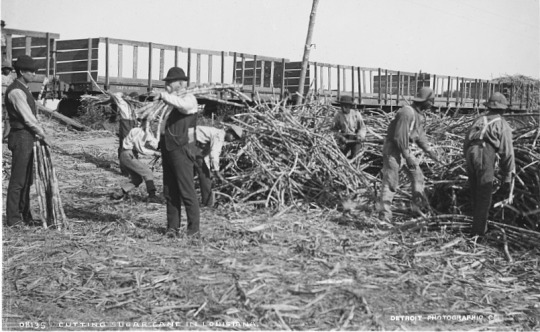
Picture taken from the Nicholls library database.
"Murder, foul murder has been committed, and the victims were inoffensive, law-abiding Negroes. Assassins more cruel, more desperate, more desperate than any who had hitherto practiced their nefarious business in Louisiana have been shooting down, like so many cattle, the negroes in and around Thibodaux, Lafourche parish, La."
Quote taken from African American Newspaper.
This was a tragic part of history, and it should be learned about, a way to bring awareness to the horrible situation that African Americans used to live in. The massacre was a result of a labor strike blown out of proportion by the white officials in charge. It should never be forgotten that innocent people were killed that day as a result of wanton racism and power hungry officials.
2 notes
·
View notes
Text
Approximately when some of the DST characters were born
(Reminder this is all speculation!! And since we don’t have an age range for some of the characters, I will have to guesstimate*)
*guess-estimate
(OKAY SO… This has been in my drafts for a year-ish.. I planned to do more characters but lost my motivation, and now I am finally posting it)
Wilson: Born sometime around 1887-1891 on April 23. Probably born in Europe and possibly immigrated to America some time before he was taken.
He has been stated to be in his early 30’s in a Klei facebook message/post (I dont really know how to describe it) on June 17, 2014

Wilson was also canonically taken into the constant in the year 1921. This is stated in a rough timeline made by Klei developer Kevin Forbes on September 25, 2014. He is in his early 30’s (30-34) and taken in 1921, 1921 minus 34 is 1887 and 1921 minus 30 is 1891 so he was born around those years. It isn’t really set in stone if he is European or not, but it is sorta hinted to. On January 7, 2014 in a Facebook conversation it is stated that he is “roughly designed as a European, maybe a European USA Immigrant”

Willow: Possibly born around 1887-1891 on May 7. She was orphaned at a young age and then sent to an orphanage, then she burnt it down.
This was a lot harder to figure out, and with new lore always coming this birth year speculation may be proven wrong. As seen above in the first image Willow is in her early 20’s. (Also, Willow was first said to be in her Late teens, and then later said to be in Early 20’s. Personally I take the early 20’s to be more canon as it was said at a more recent time than the first age.) There is no set in stone time for when she was taken. With the knowledge of the date Wickerbottom was taken (March 29, 1911, said in the timeline I linked above ^^) we can assume she was taken sometime between 1911-1921 (1921 is when Maxwell takes in Wilson, presumably his last victim) She was probably taken not to long after Wickerbottom was taken because Willow in the constant looks the same as Willow in Wickerbottoms animation. 1911 minus 20 is 1891 and 1911 minus 24 is 1887.
Wendy: Born November 11, 1903.
I got this birth year from the timeline and it is also stated in Wendy's Dont Starve wiki page The reason the year chosen is 1903 is because “Wendy is stated to be between 8 and 10 years old. This range can be narrowed down by examining various dates from the William Carter puzzles and the image of her nightstand. Jack's letter in the third William Carter puzzle, which mentions the twins, must have been written no later than the August 1904 dates from the fourth puzzle. This means that Wendy and Abigail were born no later than August 1904. Additionally, Wendy's diary entry, which was likely written before she entered the Constant, has a date of April 16, 1914. Since Wendy's birthday is in November, her only possible date of birth is November 11, 1903.” This text is taken from the wiki linked above. ^^ If we take her diary entry and her birth year and do some math, we can figure out that Wendy is 10 years old and 5 months when she was taken into the constant.
#Don’t starve#dont starve#dst#wilson higgsbury#wilson percival higgsbury#dostarve speaks#dst lore#wendy carter#willow dst#dst wendy#klei entertainment#dont starve together#I talk about dst
11 notes
·
View notes
Text
Remembering Boris Karloff (November 23, 1887 - February 2, 1969).🕯
#horror

60 notes
·
View notes
Text
14 notes
·
View notes
Text

Boris Karloff, November 23, 1887 – February 2, 1969.
With Peter Bogdanovich during the making of Targets (1968).
16 notes
·
View notes
Text
1) A Study in Scarlet
(Back to main post)
Originally titled "A Tangled Skein"
Sherlock Holmes was originally "Sherrinford Holmes" with partner John Watson originally "Ormond Sacker"
This is the book that first established the magnifying glass as a tool used by detectives to solve crimes!
Page from the original manuscript:
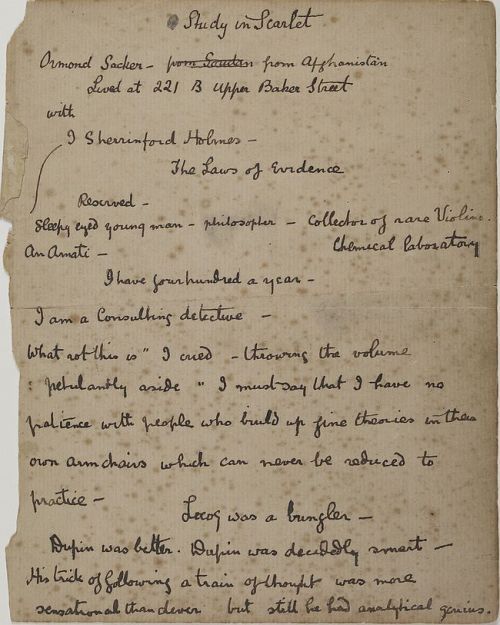
First Published in Beeton’s Christmas Annual November 1887

Extra Information:
founded by Samuel Orchart Beeton
Beeton’s Christmas Annual was sold to Ward, Lock & Co publishing
ward lock n co founded by ebenezer ward and george lock
Had three works:
"A Study in Scarlet" by A. Conan Doyle, pp. 1–95.
"Food for Powder" by R. André, pp. 96–114.
"The Four-Leaved Shamrock" by C. J. Hamilton, pp. 115–138.
Copy once sold for $156,000 at Sotheby's on 21 June 2007, estimated 75,000-125,000 USD
Original manuscript was rejected by other publishers until Ward, Lock & Co offered and accepted £25 for the copyright
(equivalent to £3,371.95 considering inflation)
he got no royalties, just a flat fee - eventually had to pay two hundred times the original price of sale to get the copyright to that one story back.
Conan Doyle wrote back to ask for a percentage on sales. Here is the publisher's answer of 2 November 1886: Dear Sir, In reply to your letter of yesterday's date we regret to say that we shall be unable to allow you to retain a percentage on the sale of your work as it might give rise to some confusion. The tale may have to be inserted together with some other in one of our annuals, therefore we must adhere to our original offer of £25 for the complete copyright. We are, dear Sir, Yours truly, Ward, Lock & Co.
illustrated by David Henry Friston
this sold originally for one shilling
ward lock n co then republished this outside of beeton’s christmas annual
Lippincott’s magazine commissioned a sequel:
The American editor of LIPPINCOTT'S MAGAZINE read it and decided to commission a sequel. He invited Sir Arthur Conan Doyle to dinner at a London restaurant with the editor and another writer he was trying to court, and during the course of the evening Sir Arthur agreed to another Sherlock Holmes novel and he went home and wrote THE SIGN OF THE FOUR, and the other writer, who was Oscar Wilde, said, "Oh, yeah, sure, I'll give you a short novel," and he went home and scribbled out THE PICTURE OF DORIAN GRAY.
A STUDY IN SCARLET sold for (the equivalent of) $2,951.39 and ran 43,704 words. Six and three-quarters cents a word. SFWA rates are five cents a word.
Page 90, line 23 second paragraph fourth line
copies that are lacking the “I” of “I fancy that he suspected…” are the true first edition, first issues of this magazine
Recorded copies
34 total confirmed
21 in libraries
University of Minnesota - 4
Yale - 3
may have had another two previously
11 complete copies with original wrappers and advertisements
one of which is bound
one has a spine
23 lack original wrappers and/or advertisements
some of which have facsimile replacements for the missing original parts
two copies are signed by ACD
one copy had. an unsigned inscription by him but the page was stolen and now missing
page 90 “I”
14 don’t
18 do
2 not available
11 extra excluded copies
either missing, unknown status, no record, or destroyed
one also might be one of the confirmed copies, matching description
link to facsimile (identical yet modern reprint):
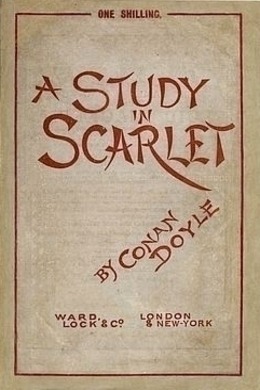
Ward, Lock & Co July 1888
Extra info:
Illustrated by his father Charles Doyle
6 of them
Charles Doyle while he was by then confined to an asylum on account of his epilepsy and alcoholism
one shilling

Philadelphia, J.B. Lippincot March 1890
First Edition
American Edition

Ward, Lock, Bowden & CO (formerly Ward, Lock & Co) 1891
Extra info:
Illustrated by George Hutchinson
Some Covers
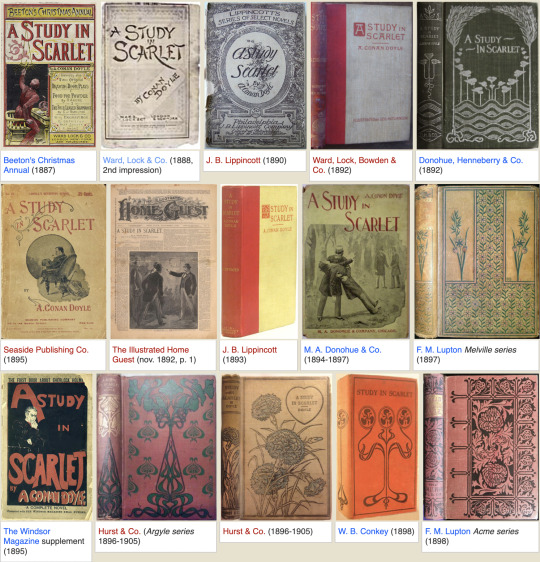
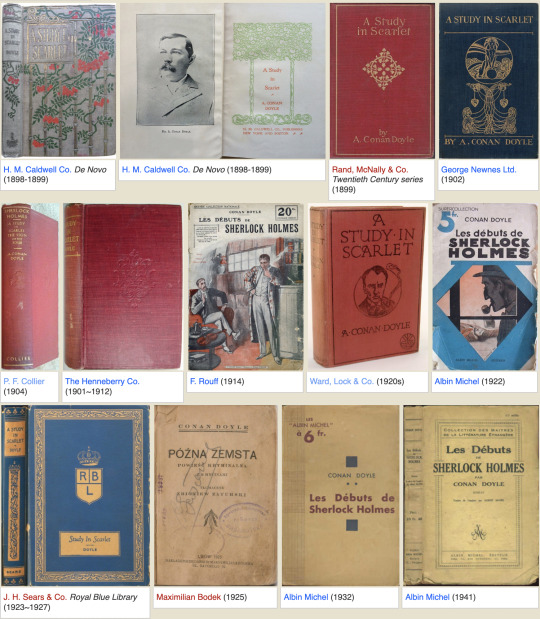
#elementary sherlock#sherlock#sherlock fandom#sherlock holmes#bbc sherlock#sherlock & co#sherlockbbc#cbs elementary#elementary cbs#autism#sherlock autism#acd johnlock#john watson#acd watson#watson#autistic#autistic things#infodump#neurodivergent#booktok#booklr#book review#bookworm#books & libraries#reading#bookblr#books#books and reading#publishing#sir arthur conan doyle
4 notes
·
View notes
Text

Remembering Boris Karloff
William Henry Pratt, better known as Boris Karloff (November 23, 1887 – February 2, 1969)
He is best remembered for his roles in horror films and his portrayal of Frankenstein's monster in Frankenstein (1931). His career experienced something of a revival in the 1960s thanks to hosting the TV anthology series Thriller (1960) and indie director Roger Corman, with Karloff contributing wonderful performances in The Raven (1963), The Terror (1963), the ultra-eerie Black Sabbath (1963) and the H.P. Lovecraft-inspired Monster of Terror (1965).
Karloff's last great role was as an aging horror movie star confronting a modern-day sniper in the Peter Bogdanovich film Targets (1968). His TV career was capped off by achieving Christmas immortality as the narrator of Chuck Jones's perennial animated favorite, How the Grinch Stole Christmas! (1966).
Karloff was also a charter member of the Screen Actors Guild and was especially outspoken regarding working conditions on sets that actors were expected to deal with in the mid-1930s, some of which were extremely hazardous. Karloff was married five times and had one daughter. He died in Sussex, England of pneumonia at age 81 and was cremated.
11 notes
·
View notes